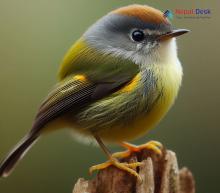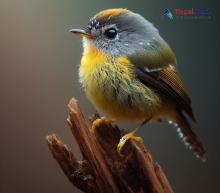The world of birds is incredibly vast and varied, encompassing thousands of species scattered across the planet. One such intriguing yet lesser-known group is the Tickellia genus, comprising small avian species that captivate bird lovers and researchers alike. In this article, we'll delve into the evolutionary history, taxonomy, morphology, ecology, and occurrence of Tickellia birds in Nepal.
Evolutionary History
Tickellia birds belong to the larger leaf warblers and allies (Phylloscopidae) family, which includes over 70 distinct species. Believed to have originated in Asia, these birds eventually diversified throughout the area. Tracing back millions of years, significant changes in climate and geography opened up new ecological niches for Tickellia birds. As they adapted to these alterations, they developed distinctive features setting them apart from other Phylloscopidae species.
Classification
Tickellia encompasses three species: the Broad-billed Warbler (Tickellia hodgsoni), Rufous-faced Warbler (Tickellia rufigenis), and Yellow-breasted Warbler (Tickellia sororum). Identified by their small stature and unique plumage patterns, these species stand out within their native environments. Research on Tickellia classification remains ongoing as new data on genetic and morphological attributes emerge.
Physical Features
Generally measuring between 9 and 11 centimeters (3.5 to 4.3 inches) in body length, Tickellia warblers are comparatively smaller than their counterparts. Their feathers often display striking color contrasts, with olive-green or brown upperparts intermingled with bright yellow or rufous hues enveloping their breast and belly regions. With a shorter tail than other warblers and slim legs and feet designed for perching and foraging amid flora, these birds exhibit unique physical characteristics.
Habitats and Behavior
Thriving in subtropical to tropical montane woodlands, Tickellia warblers favor dense undergrowth or areas close to water bodies. Feasting primarily on insects, these birds leverage their sharp vision and swiftness to catch unwary prey amid leaves or by swiftly maneuvering through the air. Their nesting habits include crafting dome-shaped nests using grass, leaves, and twigs. Known for their melodious, rhythmic tunes that reverberate throughout their forest dwellings, these species are truly enchanting.
Occurrence in Nepal
Home to diverse ecosystems, Nepal offers prime territory for various Tickellia species. The nation's lush forests and abundant biodiversity present ample opportunity for observing these birds in a natural setting. Bird enthusiasts can spot Rufous-faced Warblers within central and eastern regions of Nepal at heights of 1,800 to 3,000 meters (5,900 to 9,800 feet). Likewise, Broad-billed Warblers can be found throughout numerous montane forests across the country.
In summary, the fascinating realm of Tickellia genus birds showcases their adaptability and existence within Asia's unique ecological niches. These captivating creatures become captivating subjects for study among both amateur birdwatchers and experienced ornithologists. As we continue uncovering more details on the evolution and ecology of Tickellia birds, we deepen our admiration for Earth's remarkable biodiversity.




